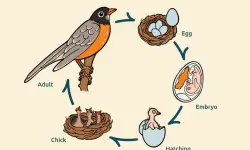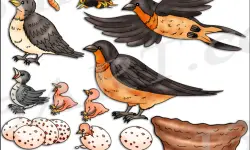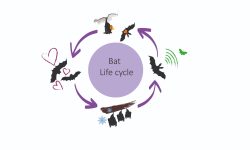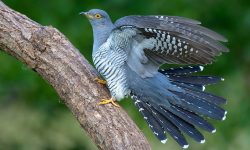Hawaii’s wetlands, though limited in area, host a fascinating cast of long-legged shorebirds. Among the most graceful of these are the Hawaiian Stilt, a native treasure, and the American Avocet, a seasonal visitor from afar. These two waders represent different ecological stories—one deeply rooted in the islands, the other just passing through. Their presence reflects the biodiversity and ecological importance of Hawaii’s fragile wetland habitats.
The Hawaiian Stilt: Hawaii’s Endemic Wader
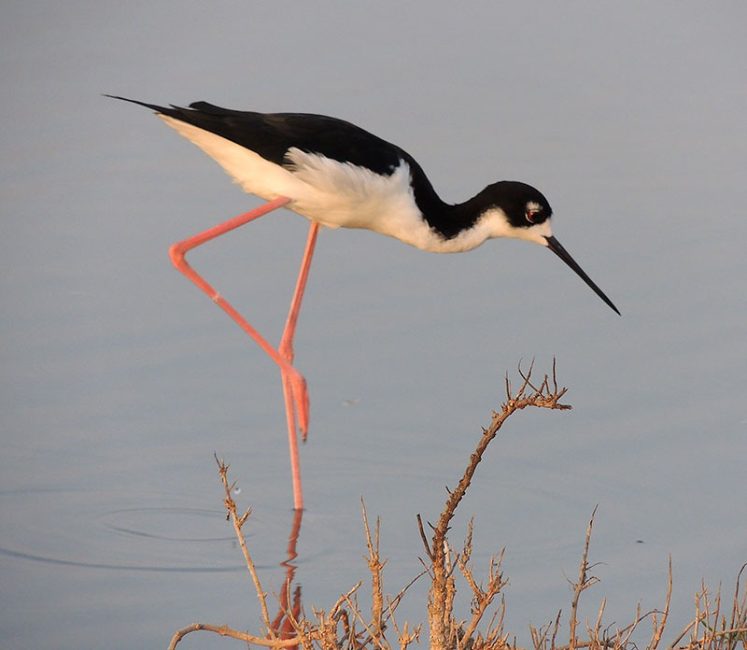
Description and Appearance
Tall, slender, and impossibly graceful, the Hawaiian Stilt (Himantopus mexicanus knudseni), or Aeʻo as it is known in the Hawaiian language, is one of the most striking birds to grace the islands’ wetlands. With legs flushed pink like coral reefs at dawn, it strides through shallow water with the elegance of a dancer. Its stark black-and-white plumage—black crown and back contrasting with a bright white underbelly—gives it a formal, almost tuxedoed appearance.
Though it closely resembles its mainland relative, the Black-necked Stilt, the Hawaiian subspecies is darker overall, with more extensive black markings on the neck and back and wings that are slightly shorter—an adaptation perhaps shaped by its island environment. The bird’s needle-straight black bill, perfectly engineered for probing the mud, completes its uniquely refined silhouette.
Its legs, which are among the longest relative to body size of any bird in the world, are not just for show—they are an essential tool for navigating the often-flooded, uneven terrain of Hawaii’s coastal marshes and ponds.
Habitat and Distribution
The Aeʻo is endemic to Hawaii, meaning it is found nowhere else on Earth. Historically widespread, it now survives in scattered lowland wetlands across several main islands. You’re most likely to find it in Oʻahu, Maui, Kauaʻi, and Hawaiʻi Island, where it inhabits a mosaic of natural and human-made wetlands—brackish coastal ponds, fishponds (loko iʻa), salt flats, taro fields (loʻi), and the shallow margins of reservoirs.
These wetlands, though fragmented and under pressure, offer the stilt a fragile refuge. In some places, such as Kealia Pond National Wildlife Refuge or James Campbell NWR, Aeʻo populations persist year-round. In others, they survive in agricultural ditches or urban marshes—reminders of how much habitat the species has lost.
Wetland degradation, particularly the draining of coastal plains for urban and resort development, has significantly reduced the Aeʻo’s historic range, pushing it closer to the brink.
Behavior and Diet
The Hawaiian Stilt is a diurnal forager, moving slowly and deliberately through ankle-deep water, using its keen eyesight and precision bill to snatch prey from mud and water. Its diet is dominated by aquatic invertebrates—midge larvae, small shrimp, worms, water beetles, and occasionally tiny fish or tadpoles. The stilt’s method is more direct than that of the American Avocet; it stabs and probes, often with startling accuracy, into soft sediment where prey hides.
The Aeʻo is also intensely social during the breeding season, which typically runs from March to August. Males and females form loose colonies, nesting in small scrapes on open mudflats or low mounds in marshy areas. Their nests, though simple, are placed with strategic care—near food sources but above flood levels.
When threatened, stilts exhibit bold, fearless behavior. Despite their delicate appearance, they are fiercely territorial, engaging in aerial dives, alarm calls, and wing displays to deter predators—particularly invasive species like mongooses, rats, feral cats, and even aggressive birds such as cattle egrets.
Parental care is shared. Both male and female incubate the eggs and tend the chicks, leading them through shallows to feed just hours after hatching. These behaviors make the Hawaiian Stilt not only a striking bird to watch, but one with deep ecological intelligence and resilience born of adaptation.
Conservation Status
The Hawaiian Stilt is listed as Endangered under the U.S. Endangered Species Act and recognized as one of the most at-risk native birds in the Hawaiian Islands. Current estimates place the wild population at only 1,500 to 2,000 individuals, with numbers fluctuating in response to rainfall patterns, predator pressure, and habitat availability.
Major threats include:
-
Habitat loss and fragmentation from development and land use changes
-
Invasive predators such as mongooses and rats that prey on eggs and chicks
-
Sea-level rise and flooding, which threaten low-lying nesting sites
-
Disturbance from human activity, including off-leash dogs and vehicles near wetlands
Conservation efforts are active and ongoing. Protected areas such as wildlife refuges, wetland restoration sites, and fenced nesting zones have played key roles in stabilizing some populations. Additionally, community science, cultural stewardship, and educational programs have helped increase awareness of the Aeʻo’s ecological importance.
In Hawaiian culture, the Aeʻo has long been regarded as a messenger and guide—a bird that walks between land and water, past and future. To protect the stilt is to preserve not only biodiversity but also a living connection to Hawaii’s natural and cultural heritage.
Conservation Status
Listed as endangered under the U.S. Endangered Species Act, the Hawaiian Stilt faces ongoing threats from habitat loss, introduced predators, sea-level rise, and human disturbance. Only about 1,500–2,000 individuals are estimated to remain in the wild. Conservation efforts focus on habitat restoration, predator control, and wetland management.
The American Avocet: A Graceful Visitor
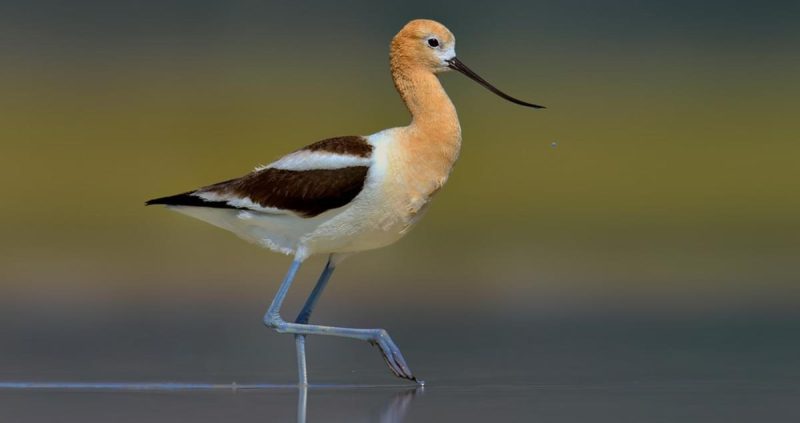
Description and Identification
With its slender silhouette, porcelain-white body, and striking black wing patterns, the American Avocet (Recurvirostra americana) cuts a graceful figure across shallow waters. What sets this bird apart from other waders is its distinctively upturned bill—a delicate curve that gives it both elegance and purpose. During the breeding season, this wader transforms into a showstopper: its head and neck flushed with warm cinnamon tones, a contrast to its monochrome wings and back.
However, by the time it reaches Hawaii, often during winter months, its colors fade into a more subtle palette of grayish-white and soft black—an understated look that still captivates those lucky enough to spot one. In flight, their contrasting wing stripes form a vivid pattern, flashing like ink against the sky, adding to the avocet’s reputation as one of the most elegant migratory shorebirds in North America.
Migration and Occurrence in Hawaii
Unlike the Hawaiian Stilt, the American Avocet is not a permanent resident of the islands. It is a rare and unpredictable visitor, arriving primarily between October and April, often as a lone traveler or in small groups. Most avocets breed far inland—across saline wetlands, playas, and prairie lakes of Utah, Nevada, California, and other parts of the western United States.
From these inland breeding grounds, some avocets migrate toward coastal regions for the winter. A few, carried perhaps by weather systems or navigational drift, find their way to Hawaii’s shorelines—a remarkable journey of over 2,000 miles across open ocean. In the islands, they are typically observed in coastal lagoons, salt ponds, evaporation basins, and protected wetland reserves, with most sightings on Oʻahu and Maui, and occasional appearances on Kauaʻi.
Feeding and Behavior
The American Avocet’s foraging behavior is a study in elegance. Unlike the probing method of the Hawaiian Stilt, the avocet’s feeding style is defined by slow, sweeping side-to-side motions of its long, upturned bill. As it wades through the shallows, the bird rhythmically skims the water’s surface, detecting and capturing small aquatic prey by touch. This technique is highly effective in silty or brackish environments, where visibility is low but food is plentiful.
Its diet includes tiny crustaceans, aquatic insects, brine shrimp, and mollusks, which it disturbs from the substrate or scoops from the water column. Avocets often forage in loose flocks and, despite their rarity in Hawaii, may briefly form small, social feeding groups if conditions are favorable.
Avocets are also known for their vocalizations—a series of high-pitched, flutelike calls that seem at odds with their quiet demeanor. These calls, though rare in Hawaii, add a touch of liveliness to otherwise calm wetland scenes, making any sighting feel a little more magical.
Conservation and Global Context
Globally, the American Avocet is listed as a species of Least Concern by the IUCN, thanks to relatively stable populations throughout much of its North American range. Still, the bird is not immune to threats. On the mainland, its breeding success is closely tied to healthy wetland systems, many of which are vulnerable to urban expansion, water diversion, agricultural runoff, and climate change-induced droughts.
In the Hawaiian context, the avocet plays a different role. Here, it is not a breeding bird or a common seasonal fixture, but a rare guest, appearing only in scattered records. Its unexpected presence, however, carries weight. These sightings offer subtle yet powerful indicators of habitat quality, migratory drift, and the interconnectedness of global ecosystems. A visiting avocet implies that Hawaiian wetlands still provide enough food, shelter, and safety for even the most serendipitous of travelers.
To birdwatchers and researchers, each avocet spotted in Hawaii is a moment of wonder and a symbol of ecological resilience. In the broader story of Pacific flyways and global avian migration, the American Avocet represents both fragility and strength—a delicate visitor whose long journey serves as a poignant reminder of how distant landscapes remain intimately connected by wings and water.
Shared Wetlands, Different Stories
Contrasts Between the Two Species
In the shimmering wetlands of Hawaii, where reeds ripple in the breeze and sunlight dances across tidal pools, two long-legged birds cross paths—briefly, yet meaningfully. The Hawaiian Stilt, with its striking contrast of inky black and bright white, is a child of the islands. It belongs here, evolved over generations to thrive in the archipelago’s lowland marshes and fishponds. This bird, locally known as the Aeʻo, is more than just a species—it is part of the cultural and ecological fabric of Hawaii.
In contrast, the American Avocet is a graceful visitor from distant shores. It arrives sporadically, a fleeting presence that touches down during its long migratory journey across the Pacific. Unlike the stilt, which calls Hawaii home year-round and depends entirely on its wetlands for survival, the avocet’s relationship with the islands is temporary, almost incidental. Yet its presence is no less significant.
Their physical similarities—slender frames, long legs, elegant profiles—belie profound differences in lifestyle, origin, and survival strategy. The Hawaiian Stilt walks with territorial purpose, defending its nest sites fiercely, raising chicks in warm months, and foraging with methodical jabs into the mud. The American Avocet glides through its brief Hawaiian sojourn with gentle ease, its upturned bill swaying side to side in the shallows like a painter’s brush, skimming food from the water column.
Even their approaches to feeding reflect a kind of poetic contrast: the stilt’s straight bill pierces the surface with precision, targeting hidden prey, while the avocet’s curved bill caresses the water, stirring life into motion. These complementary techniques allow both birds to share space without direct competition, embodying the ecological principle of niche partitioning in one of its most elegant forms.
Why Their Presence Matters
Together, these two birds—one native, one nomadic—form a narrative of biodiversity and interconnection. The Hawaiian Stilt serves as a living barometer of the islands’ environmental health. Its dwindling numbers reflect the pressure of habitat loss, invasive predators, and changing coastlines. To lose the Aeʻo would be to erase a piece of Hawaii’s natural identity.
The American Avocet, on the other hand, tells a story that reaches far beyond the Pacific. Its unexpected appearances in Hawaii are threads in a vast migratory tapestry that connects North America’s interior wetlands with far-flung coastal refuges. Even in its rarity, the avocet reminds us that Hawaii’s wetlands are not isolated—they are part of a global network of stopovers, vital to birds navigating immense journeys across continents and oceans.
For conservationists, these species symbolize different but equally urgent calls to action: one, to protect what is precious and irreplaceable; the other, to support what is transient yet deeply dependent on healthy ecosystems.
And for birdwatchers, there is magic in seeing them side by side. The resident and the wanderer. The sentinel and the surprise. In their coexistence, however brief, we witness the harmony of nature’s timing, the rhythm of tides and seasons, and the silent choreography of life that plays out in Hawaii’s overlooked but critical wetlands.
Their shared presence in these fragile habitats challenges us to look closer, care deeper, and understand more fully how even distant lives converge in a few shallow inches of warm island water.
Where to See Avocets and Stilts in Hawaii
For those eager to see these waders, the best spots include:
-
Kealia Pond National Wildlife Refuge (Maui) – A stronghold for Hawaiian Stilts and occasional stopover for avocets
-
James Campbell National Wildlife Refuge (Oʻahu) – Key breeding site for stilts and excellent birding location
-
Kawainui Marsh (Oʻahu) – Urban wetland habitat supporting stilt populations
-
Salt ponds of Kauaʻi – Especially around Hanapepe, sometimes visited by avocets
Patience and timing are key—Hawaiian Stilts can be seen year-round, while avocets are most likely to appear during winter months, though never in large numbers.
Conclusion
The Hawaiian Stilt and the American Avocet, though vastly different in origin and frequency, share a common stage in Hawaii’s precious wetland habitats. Their elegance in motion and ecological significance offer a window into the delicate balance of island ecosystems. By understanding and protecting these graceful waders, we preserve more than species—we safeguard the living rhythm of Hawaii’s wetlands, where resident and traveler wade together beneath the tropical sky.

